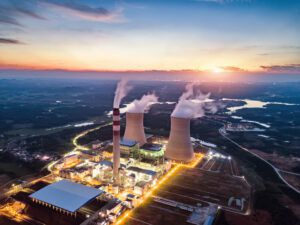Asia is experiencing a surge in nuclear power development as it seeks to secure its energy supply and transition away from fossil fuels, opening up opportunities for investors, according to research by Barclays.
The region is developing 60% of the under-construction global nuclear capacity, creating medium-term opportunities in the supply chain/capital goods companies supporting the nuclear build out in Asia, the research found.
While China and Korea are primarily focused on developing large scale nuclear capacity and benefit from a localised nuclear ecosystem, the research found large-scale reactors being developed in India and potential small modular reactor (SMR) development in ASEAN and other island countries could provide opportunities for investors.
“We see the potential for a $1trn SMR market globally by 2050 and estimate the Asia market could be a substantial part of this,” the Barclays research said.
Assuming SMRs take up 5% of total electricity share, this can easily turn into a US$30bn investment opportunity in ASEAN, in addition to potential SMR investments in China, India, Japan and Korea in the region, it added.
According to World Nuclear Association estimates, nearly 50% of the capital costs of nuclear power plants flow to capital goods companies that provide electrical and mechanical equipment, instrumentation and control systems. Construction materials represent 12% and professional services make-up 10%.
“We estimate the market for capital goods companies supporting the SMR supply chain will reach $380bn by 2050 and see utility developers being able to extract up to 30% developer premiums from constructing and operating SMRs,” according to the Barclays research.
This translates to a net present value (NPV) opportunity of $240bn, while operating services companies that provide fueling, maintenance and decommissioning services should also be beneficiaries.
ESG fund exclusions
Nuclear power may have been excluded by some ESG investors but Barclays found these funds accounted for less than 20% of Sustainable Finance Disclosures Regulation (SFDR) credit and equity funds.
This is based on its earlier research in May 2023, Zones of exclusion: Everything, everywhere but not all at once, analysing over 21,000 open-end funds representing $21.6trn of AUM, where Barclays found nuclear power was only the 10th and 9th most-excluded sector under the EU SFDR Articles 8 and 9 for corporate credit and equity funds, respectively.
Increasing numbers of investors have become more positive on nuclear since the Ukraine crisis. This is accompanied by recent recognition of nuclear as a sustainable activity in global taxonomies such as the EU Taxonomy, Korea taxonomy and Japan’s Transition Finance Framework, and EDF issued the first nuclear green bond in Europe in November 2023.
“While nuclear exclusion may depend on the mandates and strategies of individual funds, we also note that nuclear does not usually appear on asset managers’ firm-wide exclusion policies,” Barclays said.
Some asset managers have published specific guidelines on nuclear investing such as conducting due diligence and tracking other relevant considerations.
Additionally, investors’ interest in nuclear investing may have been influenced by shifts in the energy market or changes in policy and regulation.
For instance, Barclays’ 2022 investor survey revealed that more than 40% of respondents became more positive on nuclear energy in response to the sharp rise in fossil-fuel prices following the invasion of Ukraine.
